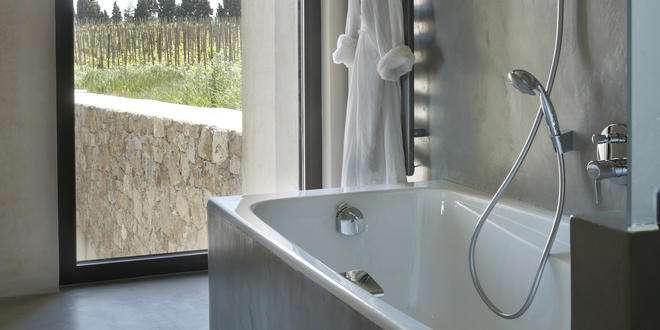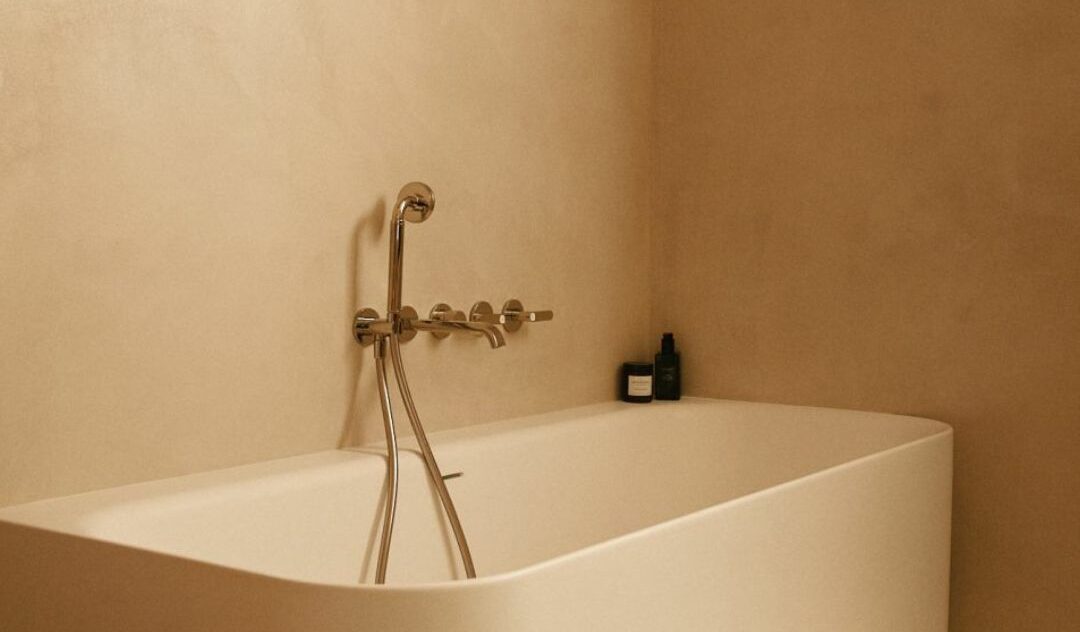The application of a varnish is an important step in the successful creation of a waxed concrete finish. This is what will determine the quality of your waxed concrete’s protection and facilitate its daily maintenance.
1/ Matt, satin or gloss?
Start by choosing the look of your varnish: most come in matte, silk matte, satin or gloss. Most of our work is done in silky matte or satin, as this retains a certain depth of material, while giving a pleasing finish to the eye.
Shiny finishes, on the other hand, are rarely used on mineral materials, as they give the surface a somewhat flashy appearance. However, gloss goes well with black, for example, or with red, to give a lacquered effect.
Finally, matte varnish gives the materials depth and a very contemporary raw look. It is particularly well-suited to walls to give them depth in relation to the light.
2/ Once the look has been determined, how do you choose the right varnish from the Marius Aurenti range?
For wall protection, we recommend our single-component acrylic wall varnish. Simple and effective, apply with a roller and criss-cross strokes. It provides sufficient protection against accidental splashes and allows the wall to be washed for regular cleaning.
In high-traffic areas, two-component HR1 and n°7 Visco polyurethane-based varnishes are the best choice. They include a base and a hardener. Marius Aurenti develops water-based varnishes, but for high-traffic areas such as kitchens, bathrooms and high-traffic floors, professionals use our range of solvent-based varnishes. These increase mechanical strength and resistance to chemical agents, and guarantee easy cleaning and longer service life.
3/ How much varnish should I use?
Once you’ve decided on the effect – matt, satin or gloss – and the type of varnish to use, you need to calculate the quantity of varnish you’ll need for your work. If, for example, you need to cover a 50 m² floor and the varnish is quoted at 250 g per square metre, you’ll need 12.5 kg of varnish. It’s important to use up all 12.5 kg of varnish, adjusting the number of coats you repeat until the entire quantity is consumed. Quantity, and quantity alone, determines the quality of protection!
As for application, avoid very thick coats. They won’t stretch very well and won’t form the film needed to protect your work.
It is therefore preferable to apply more thin coats than fewer thick ones. In addition, each varnish requires a specific drying time between coats. This time must be respected so that the new layer does not melt or technically soak the previous layer by depositing it too hastily.
4/ Good site conditions
On a building site, the temperature and humidity of the air and substrate are crucial. In fact, if you apply your varnish to concrete that’s still damp, its set will mix with the water and, once dry, the film won’t play its role in protecting against stains. It is therefore important to allow the concrete to dry, ideally 48 hours at 20° C, before applying the varnish.
Temperature also influences humidity, as it determines the speed at which the varnish sets. Ideally, you should work two days after applying your concrete, at a temperature of 20° and 65% humidity. If these conditions are not met on your site, you can use a heating or dehumidification system if necessary.
5/ Preparing the varnish
In the case of two-component varnishes, component A and component B must be mixed as indicated on the packaging. A scale is therefore necessary to prepare your mixture for a single layer. Note that solvent-based varnishes require a thin first coat with a longer drying time, usually overnight, to allow the concrete pores to be deeply sealed. Water-based polyurethane varnishes may require prior application of a pore filler.
Repeat for each coat of varnish. If you have any varnish left over after applying one coat, do not save it for the next coat, as it will have lost its stain-resistant quality.
6/ Applying varnish
When using solvent-based varnishes, make sure you have the necessary protective equipment and a special mask.
Two-component varnishes, such as HR1 or n°7 Visco, require the hardener to be thoroughly mixed with the base to ensure correct reaction. Leave to stand for five minutes before application and stir again before starting.
Before applying the first coat, it’s important to remove dust from the substrate with a vacuum cleaner, and to ensure that your worksite is dust-free between coats.
Start by applying to edges and corners using a brush or small microfiber roller. Then, for larger surfaces, use a 10 mm microfiber roller, criss-crossing the coats. A simple swipe with your hand will allow you to feel the roughness of the dust, which can be lightly sanded with 240 grit paper between coats if necessary.
Once the varnish is finished, the surface dries very quickly. It usually allows you to walk around with protective footwear on the next day, but it won’t have finished drying out yet.
Traffic is possible after three days, and a varnished surface can be wet-coated after 7 days at 20° temperature and 65% humidity.
7/ Varnishes tested and approved for over 35 years
Marius Aurenti varnishes are recognized by professionals, and have been used for over 35 years in public buildings, residential settings and intensive-use establishments. They are extremely durable and require very little renovation. A good regular cleaning system will ensure their longevity, and they can also be polished with sanding tools in the event of micro-scratches.
If, after several years, you wish to renovate your surface, you can do so by lightly sanding it with 120 grit after stripping, and renewing one to three coats of varnish if necessary. One last point: check the freshness of the varnishes and their storage conditions, to avoid freezing and extreme heat.
Good application, your job is almost done!





